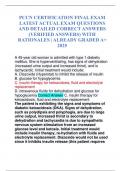PCCN CERTIFICATION FINAL EXAM
LATEST ACTUAL EXAM QUESTIONS
AND DETAILED CORRECT ANSWERS
(VERIFIED ANSWERS) WITH
RATIONALES | ALREADY GRADED A+
2025
A 45-year old woman is admitted with type 1 diabetic
mellitus. She is hyperventilating, has signs of dehydration
(increased urine output and increased thirst), and is
tachycardic. Initial treatment would include:
A. Diazoxide (Hyperstat) to inhibit the release of insulin
B. glucose for hypoglycemia
C. insulin therapy for ketoacidosis, fluid and electrolyte
replacement
D. intravenous fluids for dehydration and glucose for
hypoglycemia Correct Answer C. insulin therapy for
ketoacidosis, fluid and electrolyte replacement
The patient is exhibiting the signs and symptoms of
diabetic ketoacidosis (DKA). Signs of dehydration,
such as polydipsia and polyphagia, are due to large
urine output, increased thirst is secondary to
dehydration and tachycardia is due to sympathetic
nervous system stimulation from an increased
glucose level and ketosis. Initial treatment would
include insulin therapy, re-hydration with fluids and
electrolyte replacement. Diazoxide would not be used
since it inhibits insulin release (this patient requires
,insulin to lower glucose). The patient is not
hypoglycemia. Signs and symptoms of hypoglycemia
are similar; tachycardia, change in behavior
(irritability) or level of consciousness, sweating and
shaking.
To evaluate the outcomes of nutritional intervention for a
patient with type 2 diabetes with a dating blood sugar of
130 mg/dL three months ago, which laboratory result
would best indicate dietary compliance?
A. fasting blood sugar of 106 mg/dL or less
B. hemoglobin A1C of 6.6%
C. hemoglobin A1C of 1.5%
D. fasting blood sugar of 150 mg/dL Correct Answer B.
hemoglobin A1C of 6.6%
Hemoglobin A1C best describes the patient's blood
sugars over a 3 month period. Hemoglobin A1C
comprises hemoglobin A with a glucose molecule:
because hemoglobin holds onto excess blood
glucose, it demonstrates the average blood glucose
levels over a 3 month period and between describes
diet and medication compliance over time. Fasting
blood sugar only demonstrates the patient's last 12
hour dietary discretion.
The criteria for the diagnosis of metabolic syndrome
include:
A. hyperglycemia, hypertension, increased abdominal fat
B. low blood sugar, obesity, history of STEMI
C. low blood sugar, increased triglycerides, normal lipid
panel
,D. hyperglycemia, normal lipid panel, malnutrition Correct
Answer A. hyperglycemia, hypertension, increased
abdominal fat
Metabolic syndrome is a constellation of medical
disorders that, when occurring together, increase the
risk of developing diabetes and cardiovascular
disease, according to the 2005 NCEP update. This list
of disorders include: hypertension (BP> 130/85), high
blood sugar (fasting blood sugar>100), men with HDL
less than 40, women with an HDL<50, high
triglycerides(>150), and men with an abdominal girth
greater than 40 inches and women with an abdominal
girl greater than 30 inches.
Dehydration in hyperosmolar hyperglycemia syndrome
(HHS) is primary due to which event?
A. lack of anti-diuretic hormone (ADH)
B. inability of the kidneys to concentrate urine
C. nausea and vomiting
D. osmotic diuresis from very high blood glucose Correct
Answer D. osmotic diuresis from very high blood glucose
In HHS, the patient's blood sugar is extremely high,
causing a severe fluid deficit. This dehydration is
significant. Mortality is approximately 15% and its
typically associated with a concurrent catastrophic
illness such as a MI or sepsis or complications such
as arrhymias or cerebral edemas.
In hyperosmolar hyperglycemic syndrome (HHS) the
patient has an initial hypokalemia. The nurse should:
A. check the patient's potassium level before giving insulin
, B. monitor the heart rate before giving insulin
C. monitor the patient's level of pain before administration
of insulin
D. no precautions are necessary Correct Answer A. check
the patient's potassium level before giving insulin
The patient in HHS will have low potassium initially
and may require electrolyte replacement therapy
before insulin is started. Insulin drives potassium out
of the serum and into the cells. The resulting serum
hypokalemia can lead to cardiac arrhythmias. Once
insulin is given and a drip is started, close monitoring
of potassium is required. The patient with HHS will
have cardiac monitoring, and all patients will have
close heart rate and rhythm monitoring, however,
insulin does not require a heart rate requirement
before administration. Monitoring the patient's level of
pain is listed as a distracter.
Which of the following laboratory diagnostic findings will
most likely be seen in a disseminated intravascular
coagulation (DIC)?
A. PT and PTT prolonged
B. fibrinogen increased
C. platelet count increased
D. D-dimer within normal limits Correct Answer A. PT and
PTT prolonged
In DIC, the patient has used up all his or her
coagulation factors in making thrombus, so the PT
and PTT are prolonged. Fibrinogen will be decreased
(the body is using up all the clotting factors), platelet
count is also decreased (must be below 100,00) and




